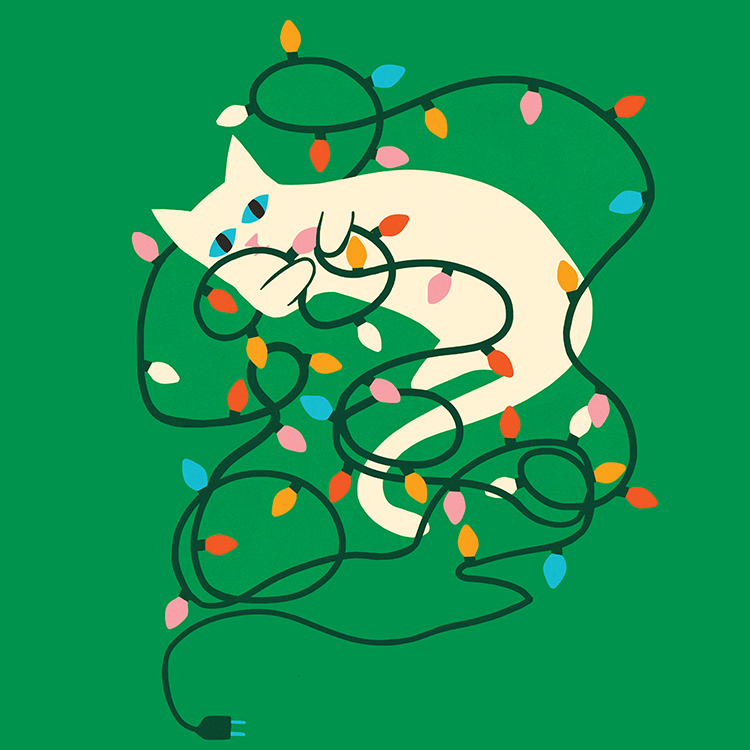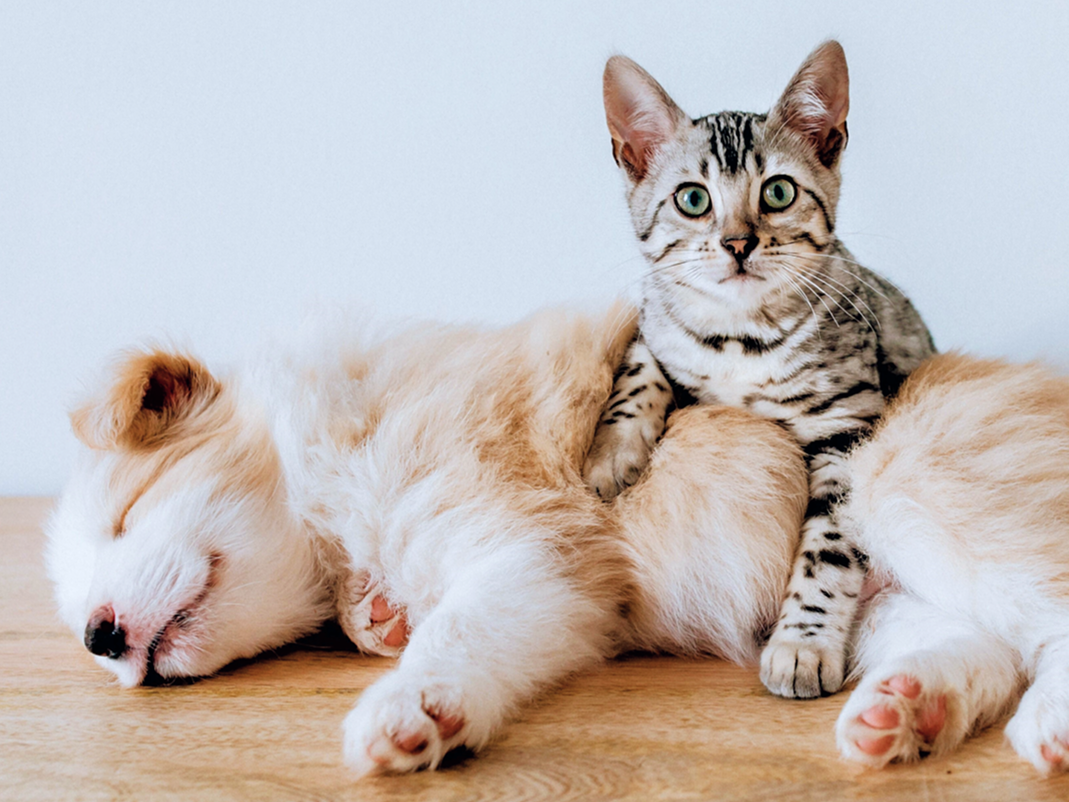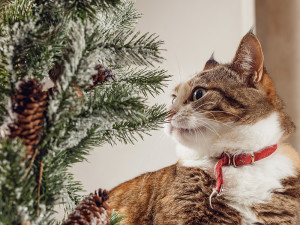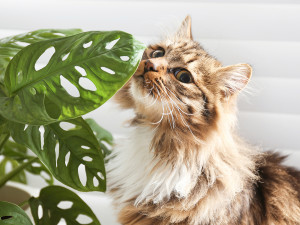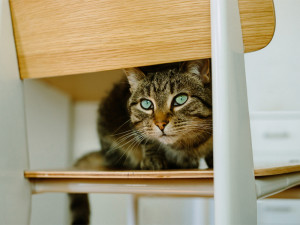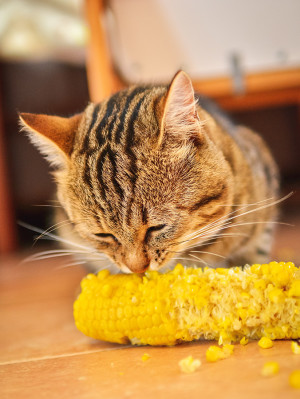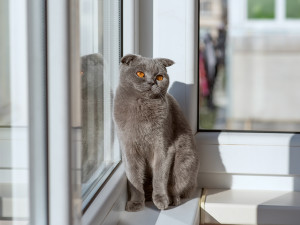Holiday Safety Tips For Overly Festive Felines
Chances are, your cat is already plotting some Christmas chaos.
Cats are curious things, both in behavior and in our understanding of them. A cat is going to go around your house where they want, when they want, and damned be any attempt to stop them — which makes it extremely hard to protect them from getting into trouble, especially around the holidays when danger abounds.
With Christmas-decorating in full swing (and Kwanzaa and Hanukkah and maybe some early New Year’s), what are some things you need to be wary of, and how can you make sure your cat doesn’t hurt themself around the sparkles and merriment?
Check out customizable policies from our friends at Lemonade Pet Insurance—so you only pay for what you need.
Christmas tree, O Christmas tree
A Christmas tree may be a point of pride in your holiday decor, but trees, especially live ones, can pose a number of dangers to your cat. The water at the base of a live tree can be very dangerous if ingested. As Dr. Aimee Simpson, Medical Director of VCA Cat Hospital of Philadelphiaopens in new tab, told us, “Christmas tree water may contain fertilizer or bacteria that can upset your cat’s digestive system. To prevent them from drinking water out of the tree stand you can use a tree skirt to cover the stand.” So if you have a live tree, be sure to keep the base well-covered.
Dr. Simpson also suggests that “you can use things cats don’t like as a deterrent around the tree.” Try wrapping the tree base in aluminum foil or placing orange peels around the base of the tree (replace every few days for maximum effect). A spruce or fir tree may also be safer than pineopens in new tab, as the sap from the latter can also be dangerous.
How much do you spend on your pet per year?
The propensity of some cats to also chew everything and jump everywhere can cause all manner of Christmas chaos. The needles from live trees can irritate a cat’s mouth, or even puncture their stomach if eaten, and the same is true for artificial trees. Cats who chew on tree lights are liable to get an electric shock, so keep the tree lights near the center of the tree so they’re harder to get to and chew on, and use a cord protector to cover the electric cable.
Dr. Simpson also suggests placing fragile ornaments up high where they’re less likely to get knocked over, and to use non-metal ornament attachments, like those from recycled paper, so that your cat can’t eat them and be harmed. She cautions to skip tinsel or anything hung on a stringlike popcorn garland, saying “these strings can cause a life-threatening intestinal obstruction if eaten.”
A cat who climbs a tree might bring the whole thing down with them, depending on the size of the cat, the size of the tree, and how much of a run-up it took trying to pounce. Be sure to securely fasten the base of your tree so there’s no wiggle room. Simpson told us that shorter trees are more secure than taller ones, to choose a location “farther away from furniture that your cat can use as a launch site to jump onto the tree,” and to use a sturdy Christmas tree stand or anchor the top third of your tree to the surrounding walls with fishing line. For a potentially safer tree alternative, look for a wooden tree like thisopens in new tab.
Please, don’t deck the halls with boughs of holly
Christmas trees aren’t the only plants that are on no-go lists for cats. There’s a whole raft of holiday (and holiday adjacent) greenery that you don’t want your pet chewing on. Poinsettias get a lot of attention, but are more an irritant to a cat’s mouth when chewed on, and only really become dangerous in large amounts. Also on the flower no-go list are lilies (regardless of time of year), amaryllis, and azaleas. Make a habit of spending 30 seconds Googling any flowers that come into your house to see if they’re pet safe — it’s an easy way to avoid potential troubles. The ASPCA keeps a list on its websiteopens in new tab, and Simpson recommends the ASPCA Animal Poison Control Center appopens in new tab to identify other potential hazards.
Holly and mistletoe are both very traditional Christmas plants, but unfortunately both are quite dangerous for cats. Holly is not only spiky, but its leaves and berries contain chemicals that can harm your pet. Thankfully, the spikes on the leaf means cats are less likely to chew on them, but berries can drop over time, so don’t count them out entirely. Mistletoe likewise should be avoided.
Try to put any plants that you’re not 100 percent sure about in areas of the house where your cat doesn’t go (if there is such a thing) and in a place they can’t reach (ditto). You can try for less accessible locations like inside a terrarium, on a bookshelf, or in a high hanging planter. If your cat likes to dig in the soil, Simpson suggests using aluminum foil or a plastic plant pot grid cover to keep them out, or provide your cat with an alternative plant they are allowed to nibble on like catnip or cat grass.
If your pet has eaten something you’re worried is dangerous, you can call the ASPCA Poison Control hotline at 888-426-4435 (though there may be a fee attached).
Come on, kitty, light my fire
Whether you’re celebrating Christmas, Kwanzaa, or Hanukkah, chances are you have some lit candles somewhere in your house. Hanukkah in particular asks you to leave your menorah lit until the candles burn out completely, which may cause an issue if you’re not paying attention. Given a cat’s innate desire to jump on every surface and rub against everything on there, that’s a recipe for disaster.
Your best bet is to swap over to electric candles if possible. Modern ones look good, have a realistic flicker, and some are even coated with a thin layer of wax so they look all but identical to the real thing. If you’re dead set on having a live flame, try and put it somewhere cat safe (again, as much as that’s a possible thing). You can also rely on tried and true methods of stopping cats from jumping on specific surfaces, like forming a perimeter of tinfoil and double-sided tape. It might not be the most festive looking option, but it’s effective. Make sure you have the candles on a large flame-proof surface, like a baking tray, so that if they do get knocked over, they don’t start a larger conflagration.
While you should never use essential oil diffusers around cats, you can, with caution, use scented candles and potpourri, says Dr. Simpson. Just keep an eye on your pet, and if they cough around the candles, skip the candles immediately.
Don’t share that dinner
On special occasions it can be tempting to give your cat a small piece of whatever you’ve cooked, just as a treat. What harm could a tiny piece of turkey or ham do? Despite the “little a salami as a treatopens in new tab” meme, Dr. Simpson recommends passing on human food. As she puts it, “The food we eat is not nutritionally balanced for cats and can cause gastrointestinal upset. Some ingredients like onion and garlic can also be toxic to cats, so it’s best to avoid giving them any human food.”
Silent night, chilled out kitty
All the excitement and hubbub of the holidays may be a stressful time for your cat, as they thrive on routines. Dr. Simpson says it’s best to keep their regular schedule as much as possible. You can also help them feel better by using pheromone products like Feliway and giving them a dedicated quiet space (a room away from everyone or just an elevated surface away from the chaos) where they can get away from things.
Regardless of what holiday you’re prepping for, there are certain steps you can take to make sure your house is cat safe (to varying degrees, anyway), but it’s always up to you to figure out what level of risk you’re comfortable with, if any.
